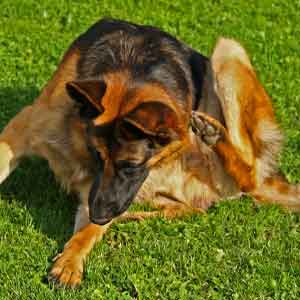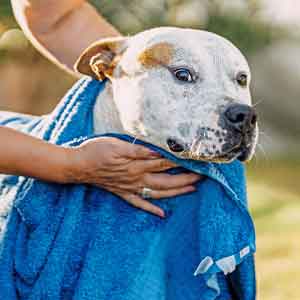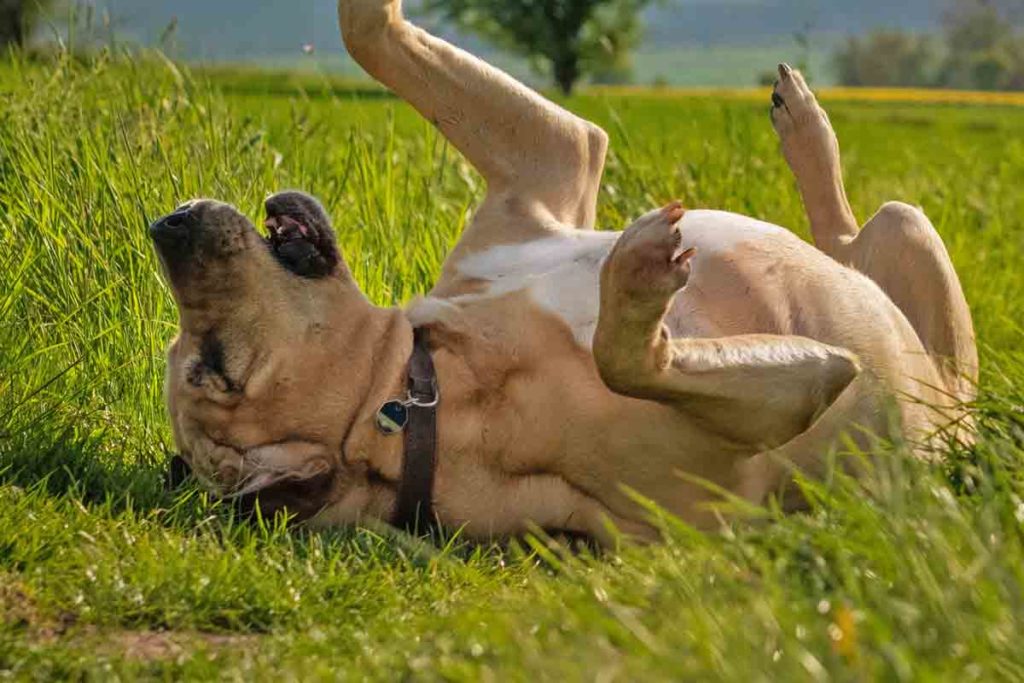Summer offers tons of great opportunities for bonding with your canine companion through outdoor activities like swimming, hiking, and outdoor play with the whole family. Warmer months are also the most common time for your dog to develop hot spots. This is especially true for those who like swimming and anything involving water. These itchy, inflamed skin lesions can affect any dog and can be quite painful. So, how do hot spots develop, and how can they be treated and prevented?
Table of contents
- What are hot spots?
- What causes hot spots?
- Treatment strategies for hot spots
- How can you prevent hot spots?
- How can ElleVet help your dog?
What are hot spots?
Hot spots are localized areas of skin inflammation and bacterial infection. Experts from the American Kennel Club (AKC) note that hot spots will often begin as a small red area. Dog owners may mistake for an insect bite. However, a hot spot will rapidly worsen and spread, developing into a red, oozing, and painful lesion. Dogs can get hot spots all year round. However, these sores are of particular concern during the warmer summer months when some of the common triggers for these sores become more prevalent.
Signs of a hot spot:
- Raw patches of redness, swelling, and hair loss
- Moist affected area
- May bleed or discharge pus or fluid, which can lead to crusting and hair matting
- Incessant licking and itching, which can worsen and spread inflammation
Hot spots will rapidly grow as your dog’s scratching continues to traumatize the affected area. While they can occur anywhere on your pup’s body, they are most commonly seen on the head, limbs, and hips.
What causes hot spots?
Hot spots can appear rather suddenly for a number of reasons. They are often initially triggered by excessive scratching, licking, or chewing a specific area of a dog’s body. AKC warns that any condition that causes your pup to itch has the potential to result in the development of a hot spot. Unfortunately, itching can lead to a self-perpetuating cycle of inflammation, secondary infections, and further itching and scratching. Common causes of this cycle include:
- Parasites and insect bites can cause itching either in one specific site or generally.
- Allergies to food or other irritants your pup may have inhaled, ingested, or come into contact with may cause an itchy allergic reaction.
- Skin or ear infections caused by bacteria or yeast can cause itchy irritation.
- Stress or boredom can make your canine companion excessively lick themselves.
- Moisture trapped in the coat from swimming, bathing, or even just humidity in the air can create a perfect breeding ground for hot spot-causing bacteria.
- Dirty or matted coats can more easily trap moisture and encourage bacterial infections to grow.

During warmer summer months, dogs are more likely to spend an increased amount of time outdoors. They are getting dirty, swimming, and getting exposed to warm weather insects. All of these activities lead to a greater risk of developing hot spots during this season.
All dogs of all ages can develop these painful wounds. However, pups with allergies, frequent infections, and long or thick coats are more likely to get hot spots. Because they spend so much time swimming and splashing, water-loving dogs also have a higher risk of getting hot spots. This all means that some breeds are naturally predisposed to hot spots:
- German Shepherds
- Golden Retrievers
- Labradors
- Rottweilers
- Saint Bernards
- …and many more
Treatment strategies for hot spots
Fortunately, hot spots can be easily treated if identified and addressed early and appropriately. Because these lesions can be triggered by underlying causes of itchy skin such as stress or allergies, hot spots can be persistent and recurring if these conditions are not addressed. You should always consult your veterinarian if your dog is exhibiting excessive scratching or has developed a hot spot. Your vet can identify the underlying cause and properly determine the best treatment strategy.
Depending on the underlying cause of your pup’s excessive itching that has led to the development of a hot spot, veterinarians may prescribe anti-inflammatory medications and or antibiotics to address secondary skin infections. To help in the healing process and to prevent further scratching and or licking, consider using an Elizabethan collar (e-collar or cone). If you and your dog cannot tolerate the cone, wearing a t-shirt or using bad-tasting sprays such as Bitter Apple can help deter licking. Shaving the hair around the hot spot can help the wound to heal and dry it out. With proper cleaning and close adherence to your vet’s instructions, hot spots usually clear up as quickly as they appear.
How can you prevent hot spots?
The best way to prevent your furry friend from developing hot spots is to control any underlying conditions. Dog parents should always have their pups on flea and tick preventatives and maintain consistent hygiene and grooming routines. If your dog swims often, shaving them for the summer or giving a short summer cut can help prevent water from remaining trapped in fur. Some dogs never seem to dry out in the summer due to a thick coat and that is prime breeding ground for hotspots.

Even if your dog has a short coat and doesn’t require a summer cut, keeping your dog clean and dry can go a long way towards preventing bacterial and yeast infections that can potentially worsen into painful hot spots. Always thoroughly dry your pup’s coat after swimming and bathing and clean their fur and skin after messy activities that leave them dirty. Your pup’s ears should also be kept clean and dry.
If your dog is experiencing stress or boredom that is leading them to incessantly scratch or lick, there are a number of things you can do to help keep their mind stimulated and body occupied with safe activities. First and foremost, making sure your dog has plenty of physical exercise is crucial—they won’t be as likely to self-harm or exhibit any destructive behaviors if they are tired from their backyard play session!
How can ElleVet help your dog?
ElleVet’s CBD + CBDA is proven effective in providing dogs support for itchy skin. We conducted a groundbreaking study in 2020 investigating the efficacy of our CBD + CBDA oil on dogs with pruritis, or itching. Results found that 65% of dogs enrolled in the study, who had not previously responded to other commonly used products, had a significant improvement in skin itchiness after using ElleVet’s CBD + CBDA, and many dogs stopped itching completely. If you are noticing excessive itching, ElleVet’s CBD + CBDA products can address this irritation and discomfort and offer skin health support, which is important for maintaining a good quality of life.
Stress in any form is not good for you or your pet. If you suspect that stress is leading to issues with excessive licking, ElleVet’s CBD + CBDA chews, soft gels, and oils can help put your dog’s mind at ease. In addressing your dog’s itchy skin, short- and or long-term stress, ElleVet’s CBD + CBDA can lead to improved overall well-being.
As always, consult your veterinarian about any issues your dog is experiencing. For any questions about ElleVet’s CBD + CBDA products or how CBD can help your canine friend live their best life, give us a call (844-673-7287) or send us an email ([email protected]). We are here to help.
Any health or medical information in ElleVet blogs is from a variety of public and reputable sources. This information is intended as an educational resource only and is not a substitute for expert professional care.









